Publications
I try to keep this publication list up to date. You can also get updates by following me on Google Scholar and ResearchGate.
Journal papers
2025
- Accounting for ground motion directionality and building orientations in urban seismic risk analysisPoulos, A., and Miranda, E.Earthquake Spectra
Regional seismic risk analysis methods are used to estimate the loss of a group of buildings subjected to earthquakes. Buildings usually have two perpendicular horizontal principal orientations, which tend to be similar among buildings within the same city due to the grid-like nature of street layouts. Current regional seismic risk analysis methods do not consider these building orientations to estimate losses because they usually consider orientation-independent measures of horizontal ground motion intensity. However, horizontal ground motions present directionality, meaning that their intensities vary with horizontal orientation. Thus, the response of a building depends on its orientation relative to the orientation of the ground motion. This work studies the effect of building orientations and ground motion directionality on groups of buildings within a city. A testbed group of buildings subjected to an example earthquake is used to estimate losses in terms of the aggregate repair cost of the buildings. The variance of these output losses is shown to be maximized when all buildings share the same principal orientations and minimized when these orientations are fully randomized. A variance-based sensitivity analysis is then performed to compare the contribution to the output variance of ground motion directionality with that of some other sources of uncertainty usually considered in regional seismic risk analyses. When buildings share the same principal orientations and the median ground motion intensities from all orientations are fixed, ground motion directionality is found to be an important source of uncertainty, and its importance increases as more buildings are considered in the analysis. These results suggest that considering ground motion directionality and building orientations could be important for future urban seismic risk analyses and that, under the same seismic hazard, the seismic risk of cities with regular orthogonal street arrangements is larger than that of cities with more irregular street layouts.
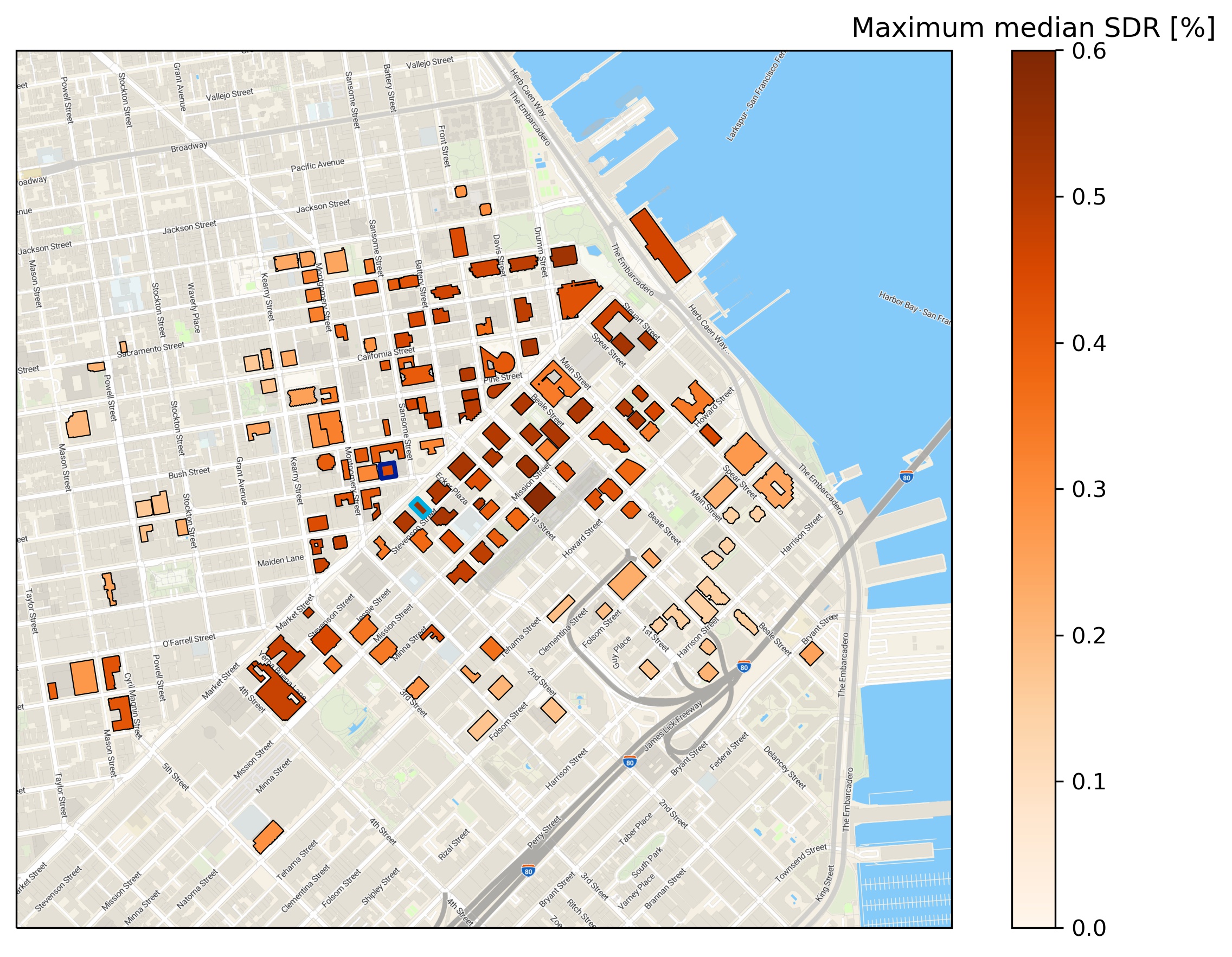 Framework for regional seismic risk assessments of groups of tall buildingsEarthquake Engineering & Structural Dynamics
Framework for regional seismic risk assessments of groups of tall buildingsEarthquake Engineering & Structural DynamicsA novel probabilistic Monte Carlo-based framework to conduct regional seismic risk assessments using simplified continuous models is proposed. The hazard at rock outcrop is defined by response spectral ordinates, which are simulated to account for spatial correlation and correlation across different periods simultaneously. For sites on firm and soft soils, a simplified site response analysis using a one-dimensional continuous non-uniform shear beam model is used to transform the hazard at rock outcrops to the hazard at all sites of interest. Uncertainty in the soil properties at each site is explicitly considered. Response spectra at each site are computed at the principal orientations of each building using recently proposed directionality models that permit the estimation of the seismic hazard at specific orientations. A one-dimensional continuous coupled shear-flexural beam model is used to simulate building dynamic properties accounting for modeling uncertainty and to obtain building responses for each building. The parameters of each model only require information on the building height and the lateral resisting system. All relevant uncertainties associated with each module of the framework are explicitly incorporated and propagated. Finally, a case study of tall buildings in San Francisco subjected to a magnitude 7.0 earthquake on the Hayward Fault is presented to illustrate how the framework can be implemented.
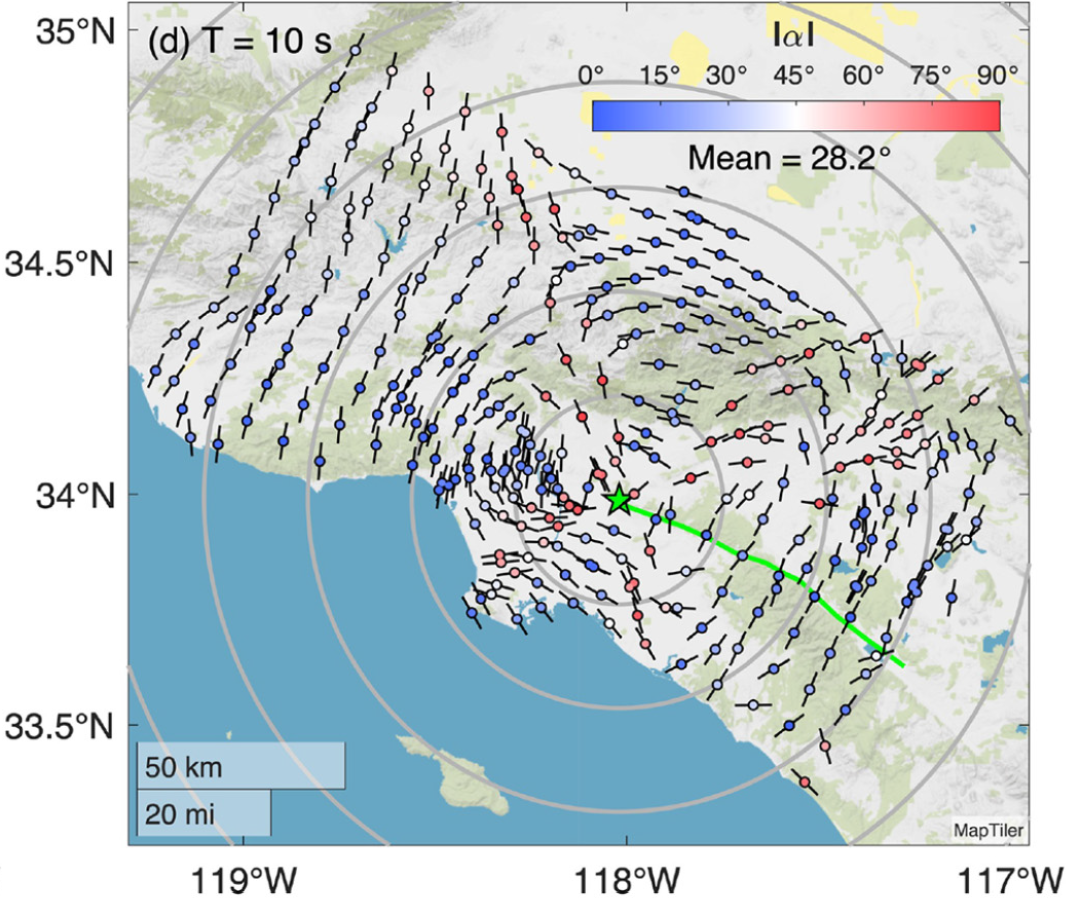 Evaluation of directionality in physics-based ground motion simulations of strike-slip earthquakesGirmay, N., Poulos, A., and Miranda, E.Earthquake Spectra
Evaluation of directionality in physics-based ground motion simulations of strike-slip earthquakesGirmay, N., Poulos, A., and Miranda, E.Earthquake SpectraRecent advances in engineering seismology and computing power have led to the development of realistic physics-based ground motion simulations. The use of these simulations for engineering applications requires that the ground motions exhibit characteristics consistent with those of recorded ground motions. While several studies have evaluated the intensity, frequency content, duration, and other characteristics of ground motion simulations for their possible use in engineering applications, few have focused on directionality. This article evaluates directionality in the response of single-degree-of-freedom oscillators when subjected to CyberShake Study 15.12 simulated ground motions from strike-slip earthquakes, by carefully comparing it to the directionality in recorded ground motions having the same style of faulting. Physics-based ground motion simulations at 334 stations from 5 different rupture variations in two large-magnitude earthquake scenarios on the Elsinore fault are evaluated. The orientation of maximum oscillator response and its spatial distribution are studied for each rupture. The orientation of maximum oscillator response is found to occur systematically close to the epicentral transverse orientation at all rupture distances, consistent with recent findings for ground motions recorded during strike-slip earthquakes. In addition, the orientation-specific spectral accelerations, when computed as a function of angular distance from the epicentral transverse orientation, are found to exhibit a variation consistent with the overall trend observed in records from the next-generation attenuation (NGA)-West2 database. However, the level of polarization at short periods in the simulated hybrid broadband waveforms used in this study is larger than that in recorded ground motions.
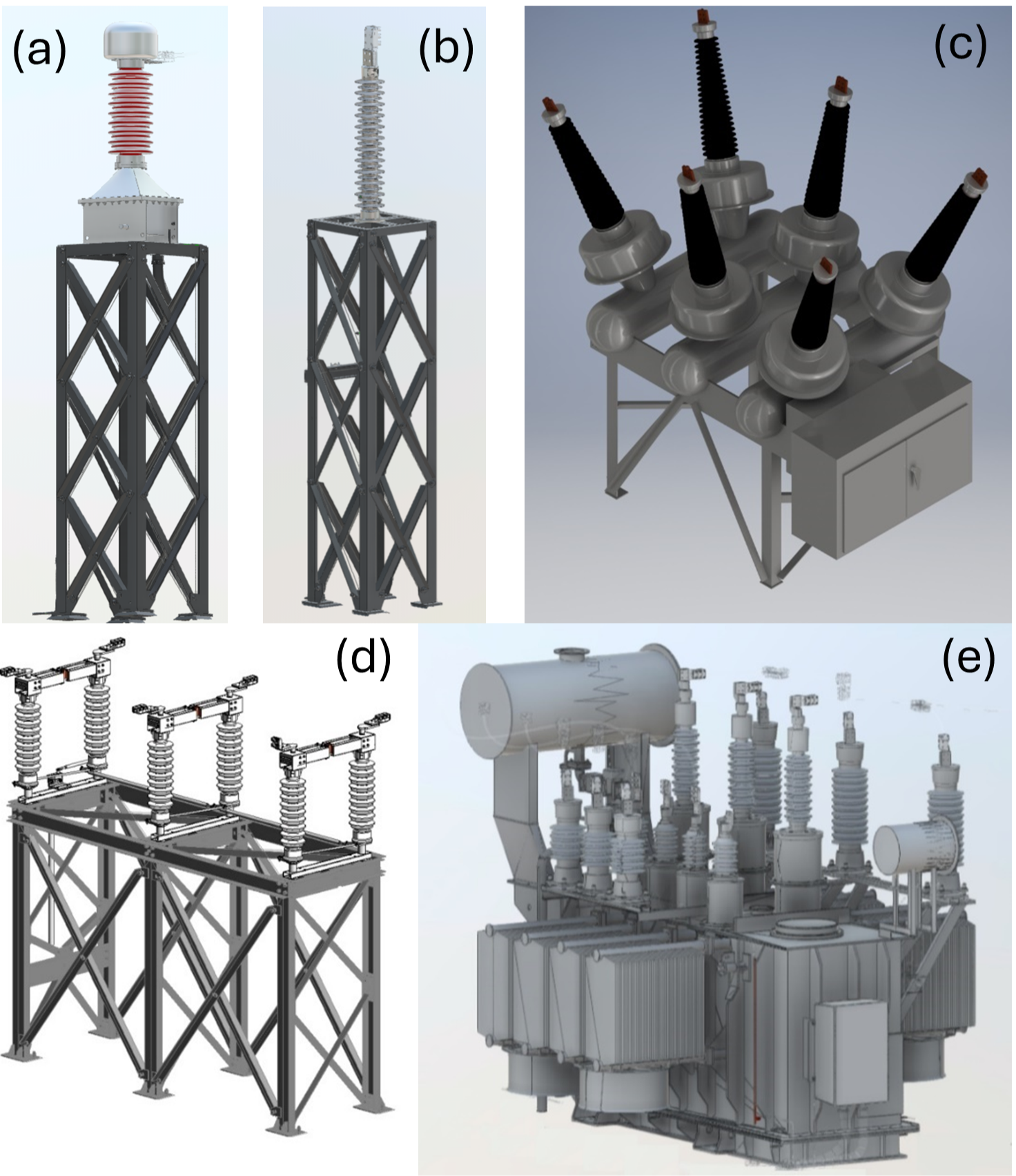 Seismic fragility estimation of electrical substations accounting for component damage and short circuit faultsAhumada, N., Muñoz, J. P., Poulos, A., Rojas, F., and de la Llera, J. C.Reliability Engineering & System Safety
Seismic fragility estimation of electrical substations accounting for component damage and short circuit faultsAhumada, N., Muñoz, J. P., Poulos, A., Rojas, F., and de la Llera, J. C.Reliability Engineering & System SafetyModern society relies heavily on electricity, which is transmitted from generating stations to final consumers through an electrical power grid. Electrical substations are key components of these grids. Previous earthquakes have heavily damaged some of these substations, affecting their functionality and leading to service interruptions. Functionality losses are usually modeled using fragility functions, which in general terms relate a seismic intensity measure with the probability of failure. Most previous studies use generic substation fragility functions that are not specific to the modeled substations. Indeed, power substations are composed of several internal components laid out in a wide range of different configurations, which cannot be accurately represented by these generic models. This study proposes a method to construct fragility functions based on the internal configuration of substation components and accounts for faults to individual lines within the substation and short circuit faults that render all the substation nonfunctional. The proposed method was applied to Chilean substations, resulting in fragility functions that vary significantly depending on their voltage level and their internal configuration. On average, the resulting fragility functions are fairly similar to the generic functions provided by HAZUS. However, fragility functions of individual substation archetypes can differ significantly between each other and with those of HAZUS. Thus, using fragility functions that consider a more realistic internal configuration of electrical components instead of generic functions can improve estimations of seismic performance, risk, and resilience of electric power grids, and hence help in providing better tools to prepare and mitigate earthquake effects.
2024
 Directionality characteristics of horizontal response spectra from the 2022 MW 6.9 Chihshang, Taiwan earthquakePoulos, A., and Miranda, E.Earthquake Spectra
Directionality characteristics of horizontal response spectra from the 2022 MW 6.9 Chihshang, Taiwan earthquakePoulos, A., and Miranda, E.Earthquake SpectraHorizontal earthquake ground motion intensity, and specifically response spectral ordinates, vary with orientation. This phenomenon is usually referred to as ground motion directionality and can be separated into two aspects: the orientation where the maximum spectral response occurs and the variation of response spectral ordinates as the orientation moves away from the orientation of maximum spectral response. This work studies both aspects using the recent 2022 MW 6.9 Chihshang, Taiwan earthquake, which was recorded by a dense network of strong motion stations with various geological and topographical settings. The mean variation of response spectral ordinates with orientation is found to be slightly more significant than that of previous shallow crustal earthquakes in active tectonic regimes. Moreover, the orientation of maximum spectral response is found to be close to the transverse orientation, which is perpendicular to the orientation at a given site that points to the earthquake epicenter, confirming prior observations made for strike-slip earthquakes. These results suggest that the location of a site relative to the seismic source could be used to modify the outputs of ground motion models to estimate spectral responses at specific horizontal orientations.
- Risk-informed representative earthquake scenarios for Valparaíso and Viña del Mar, ChileRosero-Velásquez, H., Monsalve, M., Gómez Zapata, J. C., Ferrario, E., Poulos, A., de la Llera, J. C., and Straub, D.Natural Hazards and Earth System Sciences
Different risk management activities, such as land-use planning, preparedness, and emergency response, utilize scenarios of earthquake events. A systematic selection of such scenarios should aim at finding those that are representative of a certain severity, which can be measured by consequences to the exposed assets. For this reason, defining a representative scenario as the most likely one leading to a loss with a specific return period, e.g., the 100-year loss, has been proposed.
We adopt this definition and develop enhanced algorithms for determining such scenarios for multiple return periods. With this approach, we identify representative earthquake scenarios for the return periods of 50, 100, 500, and 1000 years in the Chilean communes of Valparaíso and Viña del Mar, based on a synthetic earthquake catalog of 20000 scenarios on the subduction zone with a magnitude of MW≥5.0. We separately consider the residential-building stock and the electrical-power network and identify and compare earthquake scenarios that are representative of these systems. Because the representative earthquake scenarios are defined in terms of the annual loss exceedance rates, they vary in function of the exposed system. The identified representative scenarios for the building stock have epicenters located not further than 30 km from the two communes, with magnitudes ranging between 6.0 and 7.0. The epicenter locations of the earthquake scenarios representative of the electrical-power network are more spread out but not further than 100 km away from the two communes, with magnitudes ranging between 7.0 and 9.0. For risk management activities, we recommend considering the identified scenarios together with historical events.
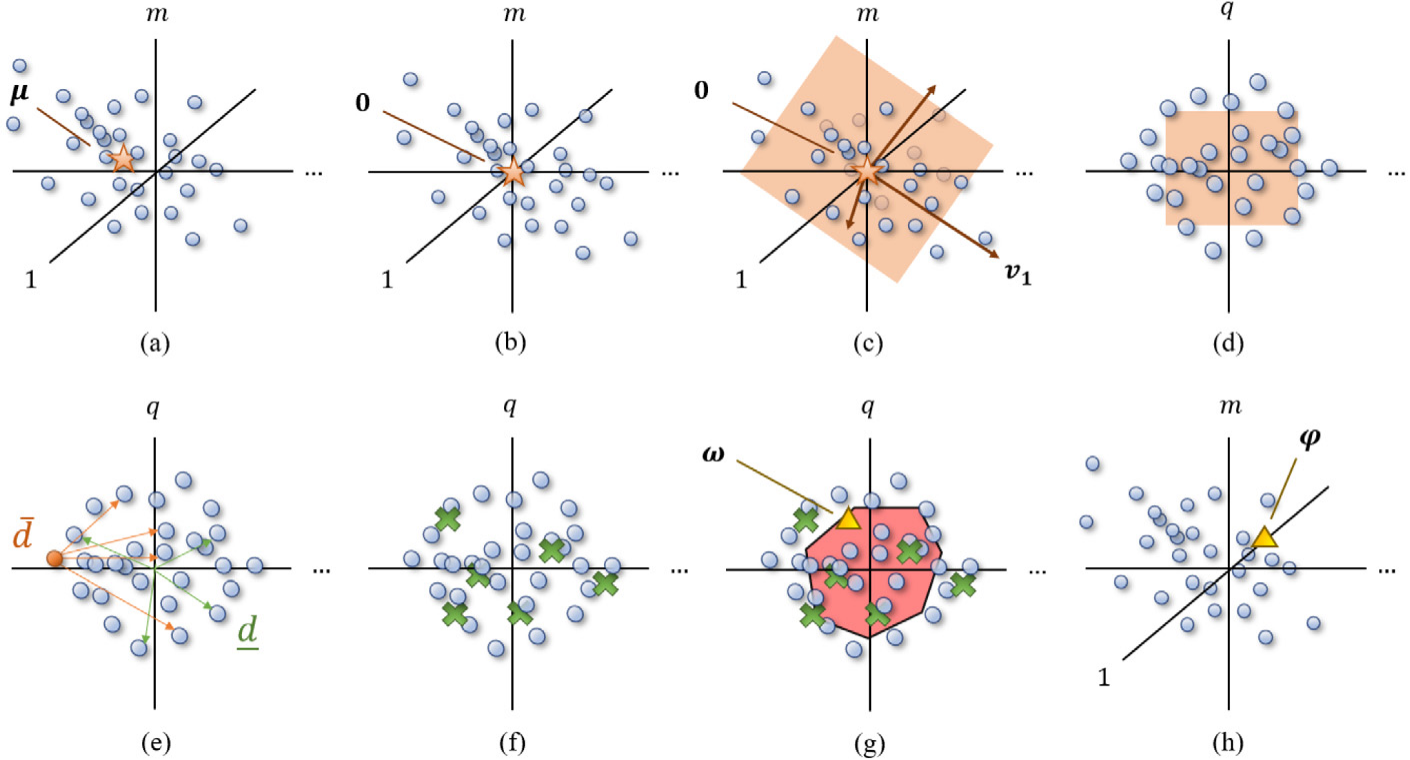 Data-driven optimization for seismic-resilient power network planningComputers & Operations Research
Data-driven optimization for seismic-resilient power network planningComputers & Operations ResearchMany regions of the planet are exposed to seismic hazards that can cause devastating consequences on power systems. Due to these systems' crucial role, the evaluation and planning for their safe and reliable operation are paramount. This paper develops a novel data-driven optimization framework to assess the power network's seismic resilience and plan cost-effective investments for its enhancement. Under a robust optimization scheme, an earthquake attacker-defender model finds the worst-case realization of random earthquake network contingencies within an uncertainty set defined with a large number of scenarios generated by state-of-the-art engineering methods. Moreover, data-driven stochastic-robust optimization is employed in a two-stage seismic-resilient power network planning model, leveraging multiple seismic sources' distributional information. Transmission line expansions and siting and sizing of battery energy storage systems are decided in the first stage, while the second stage decides operational variables. Experiments on a 281-node Chilean power system provide insights for seismic-resilient planning and demonstrate the efficiency of the proposed approach.
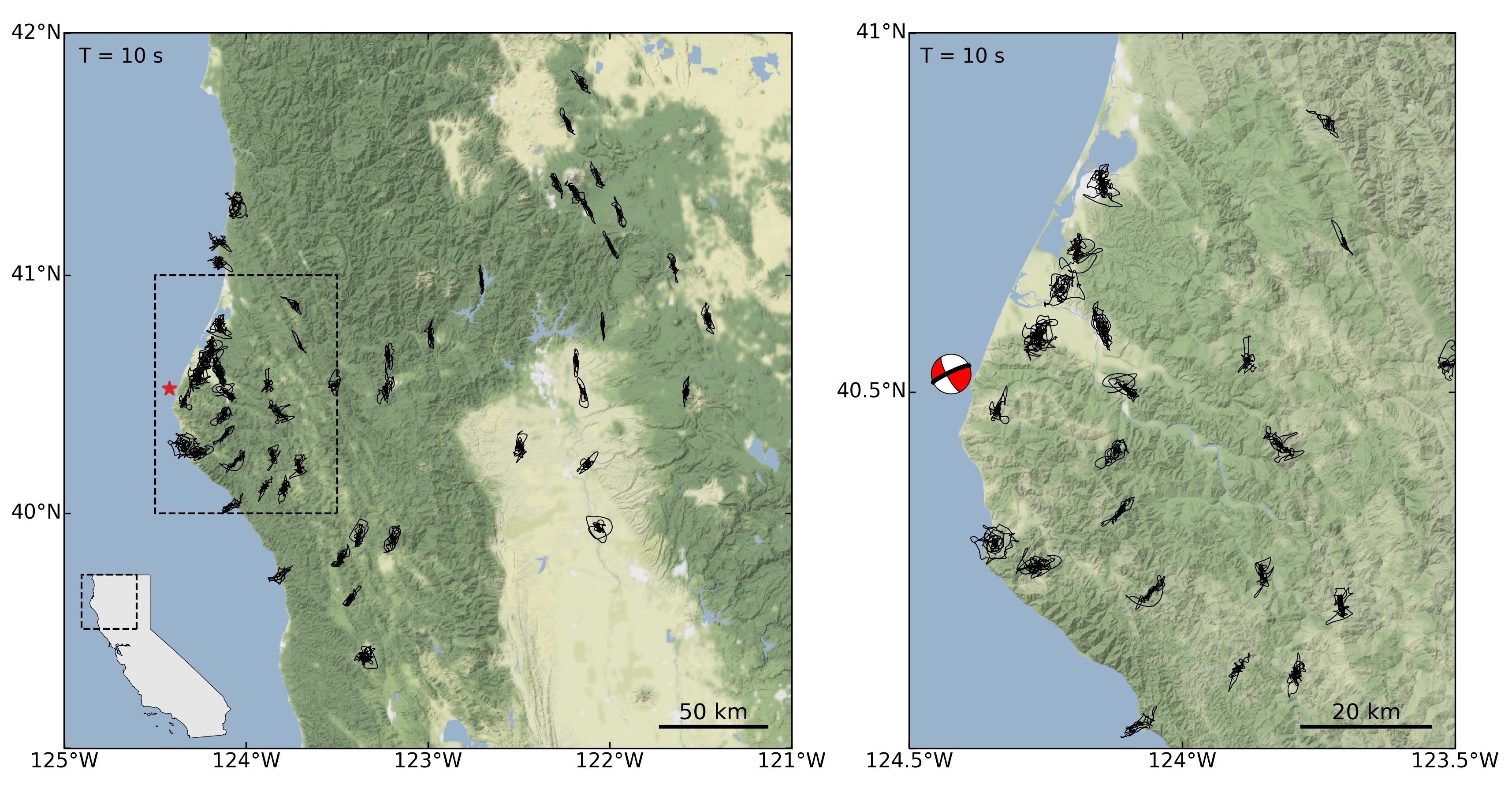 Orientation and intensity of maximum response spectral ordinates during the December 20, 2022 MW 6.4 Ferndale, California earthquakeGirmay, N., Miranda, E., and Poulos, A.Soil Dynamics and Earthquake Engineering
Orientation and intensity of maximum response spectral ordinates during the December 20, 2022 MW 6.4 Ferndale, California earthquakeGirmay, N., Miranda, E., and Poulos, A.Soil Dynamics and Earthquake EngineeringThe level of horizontal ground motion intensity can have large variations from one orientation to another. This study examines the orientation of the maximum response of 5%-damped linear oscillators and its geographical distribution for ground motions recorded during the December 20, 2022, Ferndale, CA earthquake. The orientation of the maximum intensity is found to generally occur close to the transverse orientation for epicentral distances greater than 30 km. At epicentral distances less than 30 km, the angular difference between the orientation of the maximum intensity and the transverse orientation does not show a clear predominant orientation. The angular difference with respect to the transverse orientation is found to be strongly correlated with the level of intensity. The ground motion intensity at the transverse orientation was, on average, between 85% and 95% of the maximum intensity and was 1.0–1.26 times greater than the RotD50 intensity (i.e., the median intensity from all horizontal orientations). The level of polarization increases with the period of the oscillator and ground motions remain fairly polarized up to 350 km from the epicenter. The results support a case for future incorporation of directionality effects, and in particular, the use of orientation relative to the transverse orientation, when estimating response spectral ordinates from strike-slip earthquakes.
 Directionality and polarization of response spectral ordinates in the 2023 Kahramanmaras, Türkiye earthquake doubletGirmay, N., Poulos, A., and Miranda, E.Earthquake Spectra
Directionality and polarization of response spectral ordinates in the 2023 Kahramanmaras, Türkiye earthquake doubletGirmay, N., Poulos, A., and Miranda, E.Earthquake SpectraUntil recently, the orientation of maximum horizontal spectral response was generally believed to not have a predominant orientation at rupture distances greater than 5 km. However, a recent study found that the orientation of maximum spectral response for strike-slip earthquakes in the NGA-West2 database tends to occur close to the epicentral transverse orientation, that is, an orientation perpendicular to a line connecting the epicenter to the station. This article investigates directionality in the 6 February 2023 Türkiye doublet earthquakes (MW 7.8 and 7.5) with strike-slip faulting. The orientation of the maximum response of 5%-damped linear elastic oscillators was studied. The spatial distribution of the level of polarization, which in this article refers to the amount of directionality, and intensities at specific orientations were also studied. The maximum spectral response was found to occur systematically close to the epicentral transverse orientation, consistent with previous observations for other strike-slip earthquakes. For the MW 7.8 event where the location of maximum slip was relatively far from the epicenter, it was found that the orientation of maximum spectral response is, on average, closer to the maximum slip transverse orientation (i.e. perpendicular to a line connecting the station to the surface projection of the point of maximum slip) when compared to the epicentral transverse orientation over most period ranges. This suggests that the maximum slip transverse orientation may be a better estimator for determining the orientation of maximum spectral response in large-magnitude strike-slip earthquakes, although further study using more events is warranted. Polarized motions were observed over large geographical areas, and the orientation of maximum spectral response was found to be close to the epicentral or maximum slip transverse for Joyner–Boore distances up to the farthest studied (400 km). These findings further support the case for the development of orientation-dependent ground motion models for strike-slip earthquakes.
2023
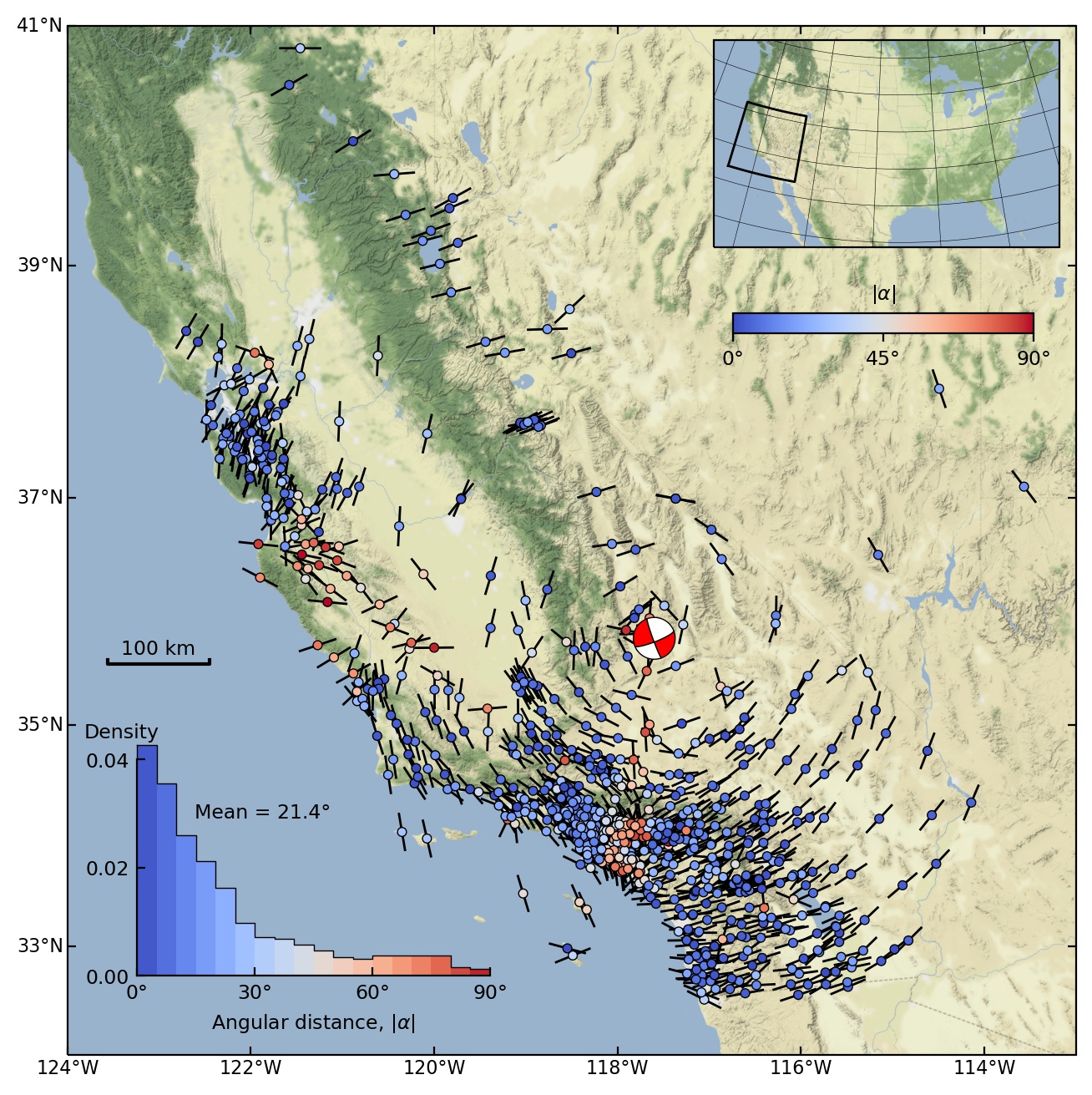 Modification of ground-motion models to estimate orientation-dependent horizontal response spectra in strike-slip earthquakesPoulos, A., and Miranda, E.Bulletin of the Seismological Society of America
Modification of ground-motion models to estimate orientation-dependent horizontal response spectra in strike-slip earthquakesPoulos, A., and Miranda, E.Bulletin of the Seismological Society of AmericaA model to estimate the 5% damped response spectra of horizontal components at specific orientations is presented. The model, which explicitly accounts for directionality, is based on prior research by the authors that identified that the orientation of maximum horizontal spectral response at a site in strike-slip earthquakes tends to occur at or close to the transverse orientation with respect to the epicenter. Using a database of 1962 ground motions recorded in shallow crustal earthquakes with strike-slip faulting, it is shown that there is a significantly larger probability of exceeding orientation-independent RotD50 intensities in the transverse orientation than in the radial orientation. Furthermore, the results indicate that, on average, spectral responses in the transverse orientation are significantly larger than those in the radial orientation and that these differences become more significant as the period of the oscillator increases. For example, spectral responses in the transverse orientation are, on average, 12% larger than those in the radial orientation for 1 s oscillators and 78% larger for 10 s oscillators. A period- and orientation-dependent model is developed and calibrated to estimate 5% damped response spectral ordinates at specific orientations by modifying orientation-independent RotD50 intensities. The proposed orientation-dependent model can explicitly account for directionality by modifying the means and standard deviations of any ground-motion model that estimates RotD50 response spectral ordinates for strike-slip earthquakes to obtain probability distributions of response spectral ordinates but now at specific horizontal orientations.
- Effect of style of faulting on the orientation of maximum horizontal earthquake response spectraPoulos, A., and Miranda, E.Bulletin of the Seismological Society of America
Horizontal earthquake ground motions have intensities that vary with changes in orientation, that is, they depend on the azimuth. Previous studies have found that the maximum horizontal spectral acceleration at mid-to-long periods is more likely to be closer to the strike-normal orientation than to the strike-parallel orientation for ground motions recorded very close to earthquake ruptures. However, this trend disappears relatively quickly as the distance to the rupture increases and becomes almost nonexistent for rupture distances longer than 5 km. Using a database of ground motions from shallow crustal earthquakes in active tectonic regimes, this work studies the orientation of maximum horizontal spectral acceleration of ground motions from earthquakes with strike-slip and reverse faulting. For strike-slip earthquakes, these orientations of maximum intensity are found to be close to the transverse orientation, that is, an orientation that is perpendicular to the line segment between the recording station and the earthquake epicenter. Contrary to what occurs with respect to the previously studied strike-normal orientation, the orientation of maximum spectral response remains close to the transverse orientation regardless of source-to-site distance. Moreover, on average, the orientations of maximum spectral response tend to become closer to the transverse orientation as the period increases. On the other hand, ground motions from reverse earthquakes do not show any trend in the orientation of maximum spectral response relative to the transverse orientation. Probability distributions of the angular difference between the orientation of maximum spectral response and the transverse orientation for strike-slip earthquakes were fitted at several periods between 0.01 and 10 s. These directionality effects from strike-slip earthquakes could be considered in future seismic hazard analyses.
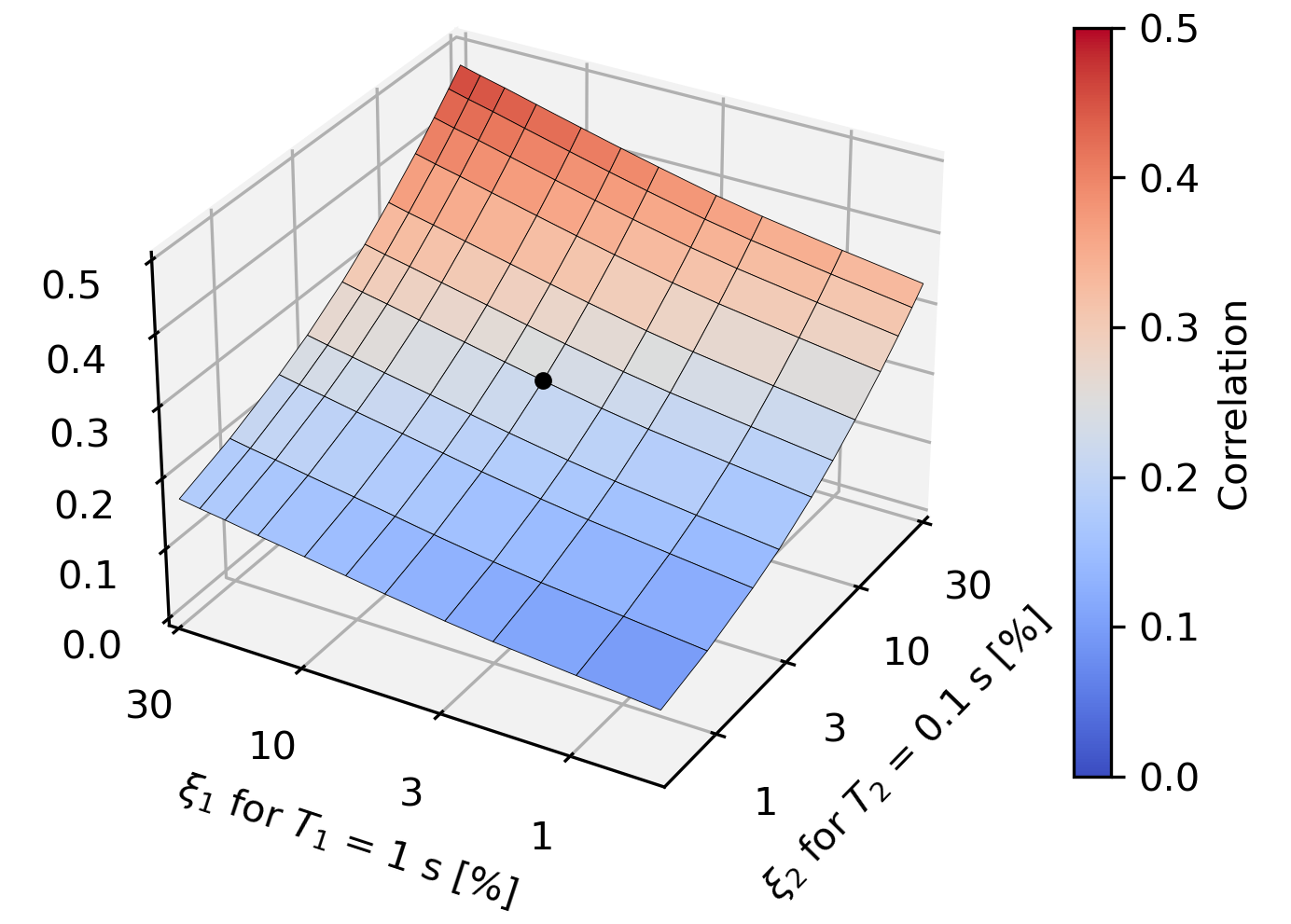 Damping-dependent correlations between response spectral ordinatesPoulos, A., and Miranda, E.Earthquake Engineering & Structural Dynamics
Damping-dependent correlations between response spectral ordinatesPoulos, A., and Miranda, E.Earthquake Engineering & Structural DynamicsCorrelations between response spectral ordinates at different periods are used in several seismic hazard computations, such as for the construction of conditional mean spectra and conditional spectra. Conventionally, these correlations have been computed and reported only for a damping ratio of 5%; however, structures may have damping ratios substantially lower or higher than 5%. Therefore, in those cases, one requires correlations of spectral ordinates at different periods but having the same damping ratios that are different than 5%, correlations of spectral ordinates at the same period but having different damping ratios, or the general case of correlation between spectral ordinates of two oscillators having different damping ratios and different periods. This work computes such damping-dependent correlations by using the NGA-West2 ground motion database. In general, it is found that correlations increase as the damping ratio of any of the two spectral ordinates increases and as the ratio of periods of vibration of the two oscillators departs from one. A nonlinear regression model is fitted to the resulting damping-dependent correlations to simplify future computations. Finally, the use of the new damping-dependent correlations is illustrated by computing example conditional spectra for damping ratios differing from 5%. The results show that using 5%-damped correlations for the construction of condition mean spectra, overestimates spectral ordinates for damping ratios lower than 5% and underestimates spectral ordinates for damping ratios higher than 5%.
2022
- Probabilistic characterization of the directionality of horizontal earthquake response spectraPoulos, A., and Miranda, E.Earthquake Engineering & Structural Dynamics
Earthquake response spectral ordinates vary significantly with changes in orientation within the horizontal plane. This variation is characterized probabilistically in this study using a large database of recorded earthquake ground motions. For each ground motion record, response spectral ordinates are computed in all horizontal orientations as a function of the rotation angle with respect to the azimuth of maximum response and then normalized by (1) the maximum and (2) the median spectral ordinate from all these orientations. Nonlinear regression models are then fitted to the means, standard deviations, and correlations of both ratios, as a function of rotation angle. To achieve a more complete probabilistic description, probability distributions are fitted to both ratios at each rotation angle. These results can be used for several probabilistic seismic hazard computations, such as the sampling of response spectral ordinates at specific orientations within the same site.
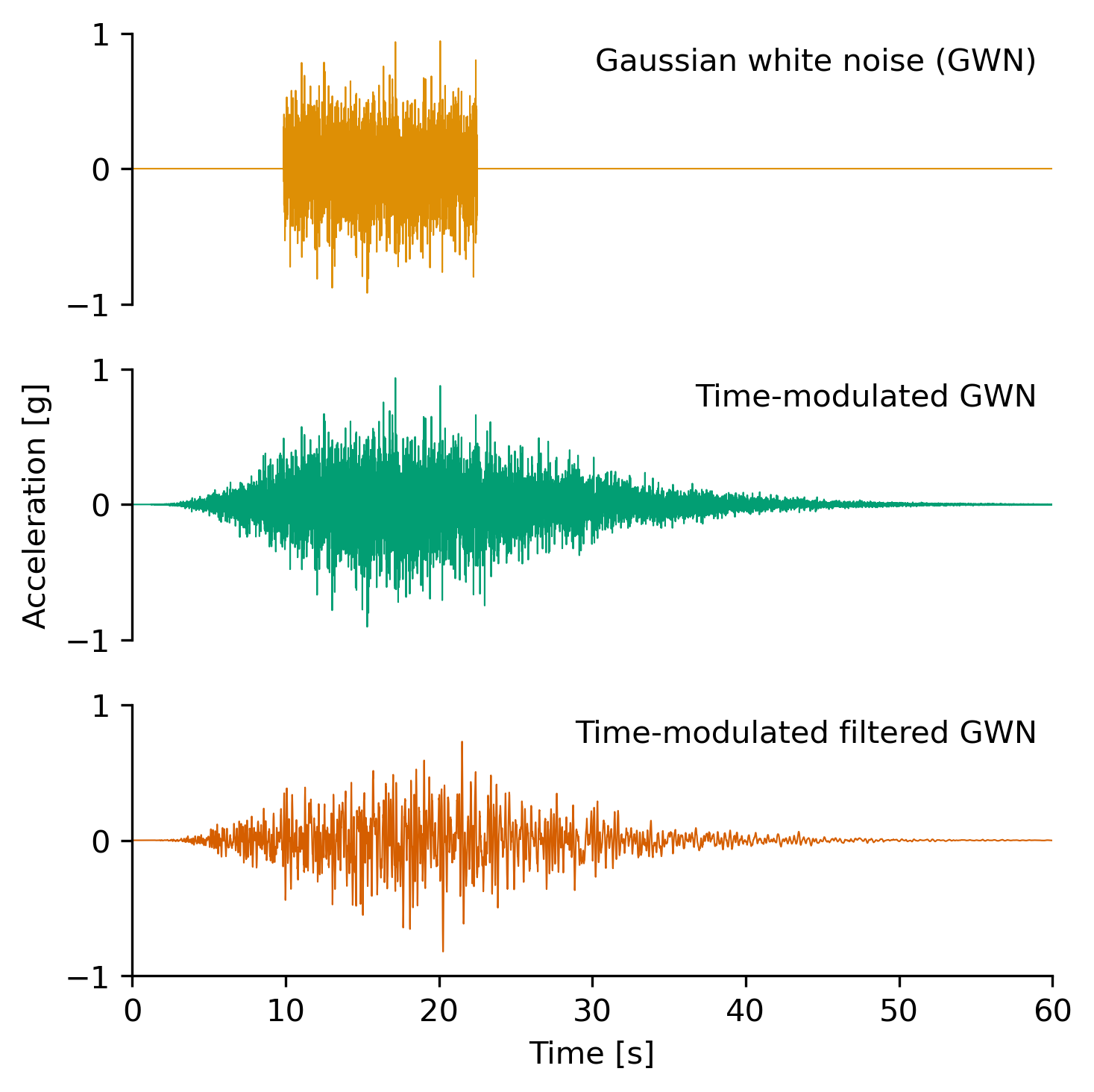 Evaluation of earthquake response spectra directionality using stochastic simulationsPoulos, A., Miranda, E., and Baker, J. W.Bulletin of the Seismological Society of America
Evaluation of earthquake response spectra directionality using stochastic simulationsPoulos, A., Miranda, E., and Baker, J. W.Bulletin of the Seismological Society of AmericaFor earthquake-resistant design purposes, ground-motion intensity is usually characterized using response spectra. The amplitude of response spectral ordinates of horizontal components varies significantly with changes in orientation. This change in intensity with orientation is commonly known as ground-motion directionality. Although this directionality has been attributed to several factors, such as topographic irregularities, near-fault effects, and local geologic heterogeneities, the mechanism behind this phenomenon is still not well understood. This work studies the directionality characteristics of earthquake ground-motion intensity using synthetic ground motions and compares their directionality to that of recorded ground motions. The two principal components of horizontal acceleration are sampled independently using a stochastic model based on finite-duration time-modulated filtered Gaussian white-noise processes. By using the same stochastic process to sample both horizontal components of motion, the variance of horizontal ground acceleration has negligible orientation dependence. However, these simulations’ response spectral ordinates present directionality levels comparable to those found in real ground motions. It is shown that the directionality of the simulated ground motions changes for each realization of the stochastic process and is a consequence of the duration being finite. Simulated ground motions also present similar directionality trends to recorded earthquake ground motions, such as the increase of average directionality with increasing period of vibration and decrease with increasing significant duration. These results suggest that most of the orientation dependence of horizontal response spectra is primarily explained by the finite significant duration of earthquake ground motion causing inherent randomness in response spectra, rather than by some physical mechanism causing polarization of shaking.
- Proposal of orientation-independent measure of intensity for earthquake-resistant designPoulos, A., and Miranda, E.Earthquake Spectra
A new measure of ground motion intensity in the horizontal direction is proposed. Similarly to other recently proposed measures of intensity, the proposed intensity measure is also independent of the as-installed orientation of horizontal sensors at recording stations. This new measure of horizontal intensity, referred to as MaxRotD50, is defined using the maximum 5%-damped response spectral ordinate of two orthogonal horizontal directions and then computing the 50th percentile for all non-redundant rotation angles, that is, the median of the set of spectral ordinates in a range of 90º. This proposed measure of intensity is always between the median and maximum spectral ordinate for all non-redundant orientations, commonly referred to as RotD50 and RotD100, respectively. A set of 5065 ground motion records is used to show that MaxRotD50 is, on average, approximately 13-16% higher than Rot50 and 6% lower than RotD100. The new measure of intensity is particularly well suited for earthquake-resistant design where a major concern for structural engineers is the probability that the design ground motion intensity is exceeded in at least one of the two principal horizontal components of the structure, which for most structures are orthogonal to each other. Currently, design codes in the United States are based on RotD100, and hence using MaxRotD50 for structures with two orthogonal principal horizontal components would result in a reduction of the ground motion intensities used for design purposes.
 Commuter welfare-based probabilistic seismic risk assessment of regional road networksReliability Engineering & System Safety
Commuter welfare-based probabilistic seismic risk assessment of regional road networksReliability Engineering & System SafetyThis study integrates welfare, a measure of the impact of road network disruption on individual commuters’ well-being, with a probabilistic seismic risk assessment framework in a computationally tractable way. Welfare is a network performance measure that reflects the differential impacts of changes in commute time on various groups. For a case study of the San Francisco Bay Area, welfare loss is computed by augmenting an origin–destination matrix with publicly available information about commuters’ income levels, residences, and workplaces. While commuters from all income groups have similar risk of drivers’ delay due to road network disruption, commuters with low incomes have a substantially higher risk of welfare loss than those with high incomes. A comparison of bridge retrofit policies shows that disaggregation of welfare loss by income group is necessary to examine whether such policies reduce risk equitably. While a retrofit policy determined using drivers’ delay reduces the expected drivers’ delay, it increases the disparity in the per-capita welfare loss of commuters with low and high incomes relative to the network’s baseline state. In contrast, a retrofit policy that prioritizes low-income commuters reduces the difference in welfare loss of commuters with low and high incomes compared to the baseline network state.
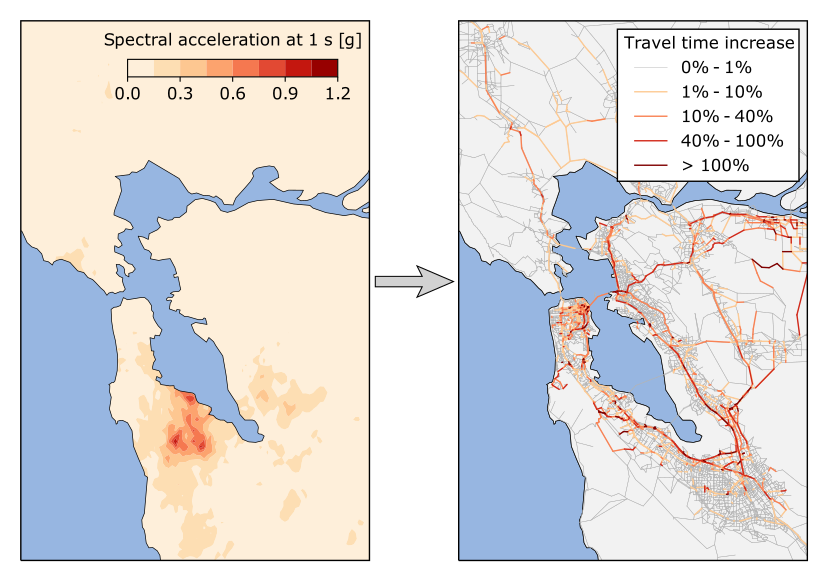 Deep learning-based retrofitting and seismic risk assessment of road networksSilva-Lopez, R., Baker, J. W., and Poulos, A.Journal of Computing in Civil Engineering
Deep learning-based retrofitting and seismic risk assessment of road networksSilva-Lopez, R., Baker, J. W., and Poulos, A.Journal of Computing in Civil EngineeringSeismic risk assessment of road systems involves computationally expensive traffic simulations to evaluate the performance of the system. To accelerate this process, this paper develops a neural network surrogate model that allows rapid and accurate estimation of changes in traffic performance metrics due to bridge damage. Some of the methodological aspects explored when calibrating this neural network are defining sampling protocols, selecting hyperparameters, and evaluating practical considerations of the model. In addition to the neural network, a modified version of the local interpretable model-agnostic explanation (LIME) is proposed as a retrofitting strategy that minimizes earthquakes’ impact on the system. The modified version (LIME-TI) uses traffic impacts (TI) and rates of occurrence to aggregate the importance of individual damage realizations during the computation of variable importance. This study uses the San Francisco Bay Area road network as a testbed. As a conclusion of this study, the neural network accurately predicts the system’s performance while taking five orders of magnitude less time to compute traffic metrics, allowing decision-makers to evaluate the impact of retrofitting bridges in the system quickly. Moreover, the proposed LIME-TI metric is superior to others (such as traffic volume or vulnerability) in identifying bridges whose retrofit effectively improves network performance.
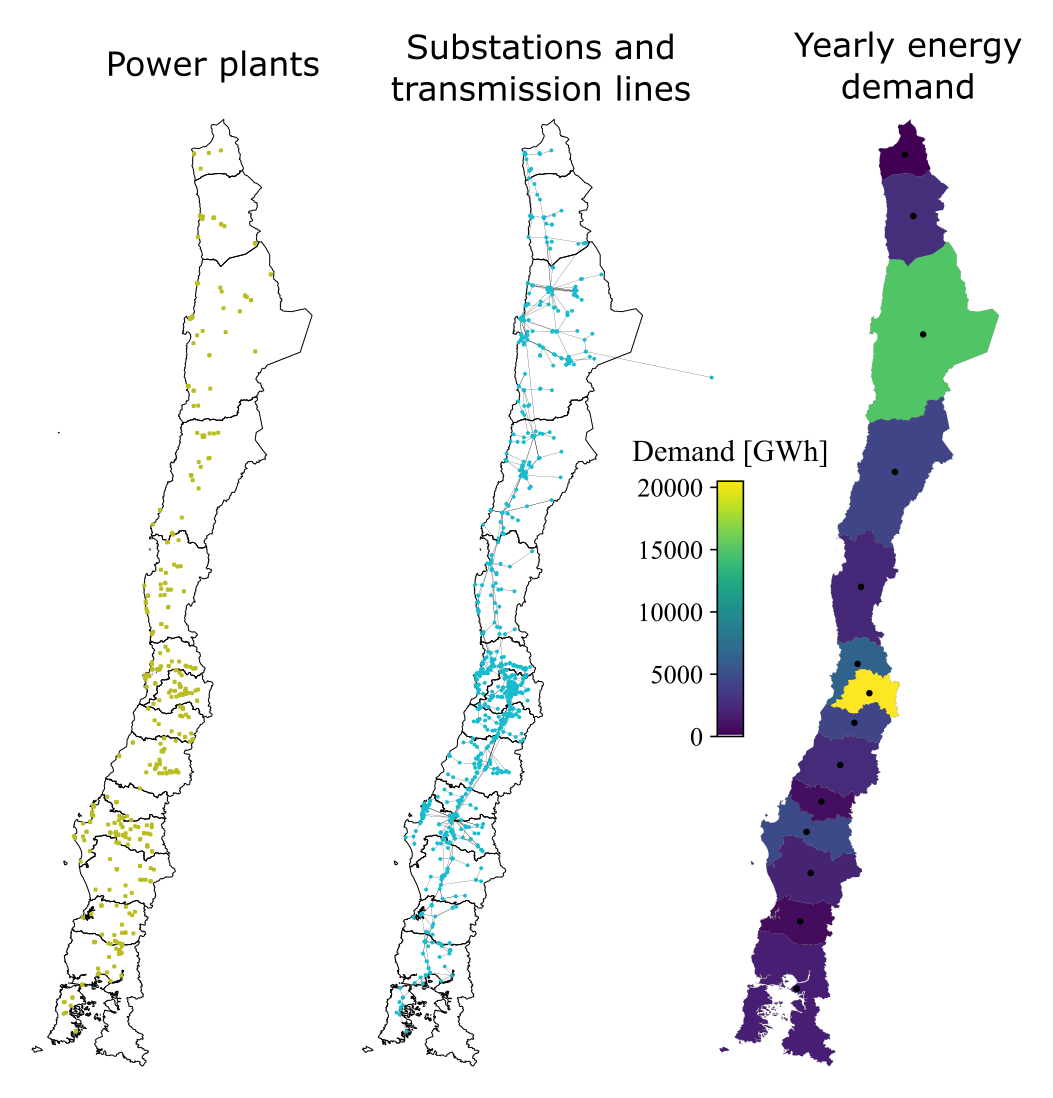 Predictive capacity of topological measures in evaluating seismic risk and resilience of electric power networksReliability Engineering & System Safety
Predictive capacity of topological measures in evaluating seismic risk and resilience of electric power networksReliability Engineering & System SafetyElectric Power Networks (EPNs) play a fundamental role in the wellbeing of modern societies and recovery of societal functions after an earthquake. Risk and resilience analyses may identify useful network characteristics to improve EPN response and recovery during and after a severe seismic event. This work computes different functional measures in order to: (i) estimate the actual risk and resilience of EPNs; and (ii) evaluate the predictive capacity of different topological measures (TMs) relative to the EPN earthquake risk performance. The analysis is carried out on the Chilean EPN at the national, regional and substation level, by using a detailed model of the network. EPN operation was modeled using the DC optimal power flow model from the time of earthquake occurrence until full system recovery using the Seismic Probabilistic Risk Assessment framework. Seismic risk and resilience estimations of Energy Not Supplied (ENS) and number of hours with ENS have been correlated with six network TMs. Linear correlation results show that TMs provide, in general, limited insight into the criticality of the Chilean EPN. In spite of that, the strongest correlation was observed for the degree TM. Moreover, the Damage Consequence Index confirmed the rather uniformly distributed seismic risk along the country.
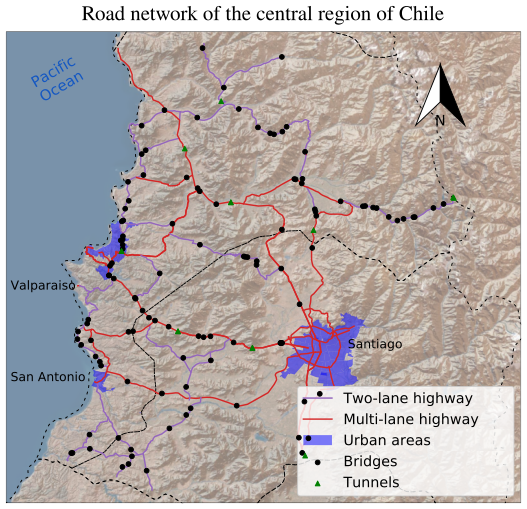 Sensitivity analysis and uncertainty quantification of a seismic risk model for road networksComputer-Aided Civil and Infrastructure Engineering
Sensitivity analysis and uncertainty quantification of a seismic risk model for road networksComputer-Aided Civil and Infrastructure EngineeringNatural hazards may cause significant disruptions to road infrastructure, subsequently affecting road agencies, users, and productive activities. Despite the existence of infrastructure fragilities to seismic hazard and some operational consequences on network mobility, previous research has not modeled risk in terms of traffic disruptions and consequent travel time delays in subduction environments, analyzing the sensitivity to model parameters and quantified model uncertainty. This study proposes a risk framework to evaluate operational consequences in interurban road networks exposed to seismic hazard using travel time delays and propagate uncertainty in the model. Risk values are evaluated using Monte Carlo simulations, and uncertainty is propagated using a polynomial chaos expansion meta-model. The framework was applied to a very critical interurban network in central Chile. Results demonstrate that the parameters that most significantly influence risk are fragility, loss of road capacity, and traffic volume.
2021
- Relations between MaxRotD50 and some horizontal components of ground-motion intensity used in practicePoulos, A., and Miranda, E.Bulletin of the Seismological Society of America
The most commonly used intensity measure of ground motion in earthquake engineering is the 5% damped spectral ordinate, which varies in different directions. Several different measures have been proposed over the years to combine the intensity of the two horizontal recorded ground motions to derive ground-motion models as well as for design purposes. This study provides the relation to seven previously used measures of horizontal ground motion with respect to a recently proposed orientation-independent measure of horizontal ground-motion intensity referred to as MaxRotD50. This new measure of horizontal intensity is defined as the median value of the maximum spectral ordinate of two orthogonal directions computed for all possible nonredundant orientations. The relations are computed using 5065 pairs of horizontal ground motions taken from the database of ground motions recorded in shallow crustal earthquakes in active tectonic regions developed as part of the Pacific Earthquake Engineering Research Center’s Next Generation Attenuation-West2 project. Empirically derived period-dependent relations are presented for three quantities that permit transforming any of the seven other definitions of horizontal ground-motion intensity to MaxRotD50, namely, (1) geometric mean of the ratio of MaxRotD50 to any of the seven other measures of intensities, (2) standard deviation of the natural logarithm of the ratio of MaxRotD50 to any of the seven other measures of intensities, and (3) the correlation between the natural logarithm of the ratio of MaxRotD50 to the other measures of intensities and the natural logarithm of the other measure of intensity. In addition, the influence of site class at the recording station, earthquake magnitude, and distance to the horizontal projection of the rupture is examined on the geometric mean of the ratio of MaxRotD50 to the median intensity of all nonredundant orientations (i.e., RotD50), showing negligible influence of site class and only a relatively small influence of magnitude and distance.
2020
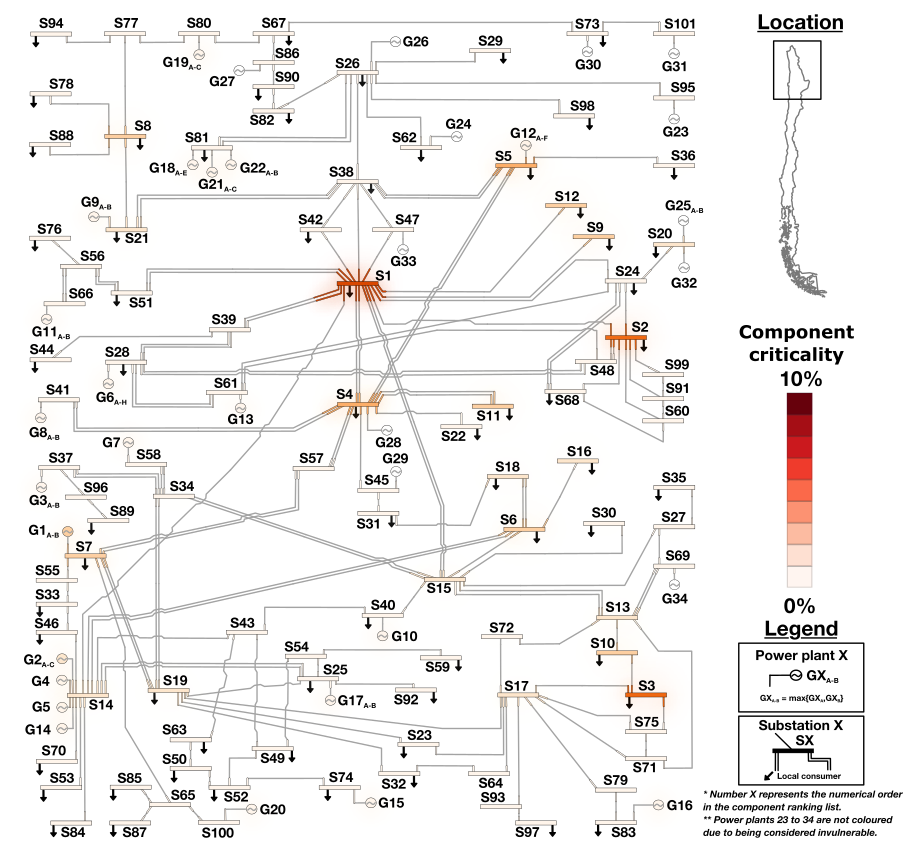 Risk and resilience assessment with component criticality ranking of electric power systems subject to earthquakesIEEE Systems Journal
Risk and resilience assessment with component criticality ranking of electric power systems subject to earthquakesIEEE Systems JournalCountries around the world suffer the dramatic impact of earthquakes and other natural hazards reflected in casualties, infrastructure damage, service interruptions, and recovery costs. Although disaster exposure consciousness of electric power systems has increased in recent years, mitigation and adaptation actions, such as reserve scheduling and infrastructure investments, are usually performed without quantitative tools to account for the underlying stochasticity of these events. This article first discusses why an integrated assessment, which incorporates sources of uncertainty (risk) and manages the time-dependency of the recovery process (resilience), should be used to assess the impact of seismic events on electric power systems. Thereafter, a probabilistic methodology that considers the hazard, vulnerability, operation, and recovery of the system is presented. As a case study, the probabilistic seismic resilience of the electric power system of Northern Chile is assessed using different risk measures, including expected annual loss, value at risk, and conditional value-at-risk. Finally, a novel criticality assessment based on these metrics is developed to demonstrate that, for certain networks such as the study case, retrofit of selective components can notably improve the resilience of the complete system to seismic events. For example, if one specific component from the 152 components of the study system is assumed invulnerable, expected annual interruption costs decrease by 8%.
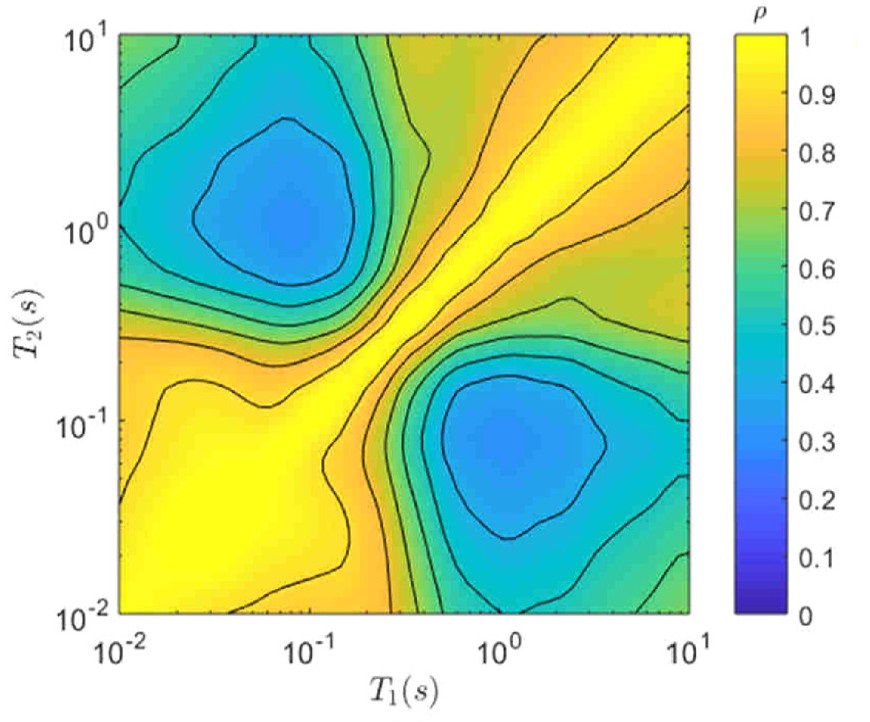 Correlations of spectral accelerations in the Chilean subduction zoneEarthquake Spectra
Correlations of spectral accelerations in the Chilean subduction zoneEarthquake SpectraThe correlation between spectral accelerations is key in the construction of conditional mean spectra, the computation of vector-valued seismic hazard, and the assessment of seismic risk of spatially distributed systems, among other applications. Spectral correlations are highly dependent on the earthquake database used, and thus, region-specific correlation models have been developed mainly for earthquakes in western United States, Europe, Middle East, and Japan. Correlation models based on global data sets for crustal and subduction zones have also become available, but there is no consensus about their applicability on a specific region. This study proposes a new correlation model for 5% damped spectral accelerations and peak ground velocity in the Chilean subduction zone. The correlations obtained were generally higher than those observed from shallow crustal earthquakes and subduction zones such as Japan and Taiwan. The study provides two illustrative applications of the correlation model: (1) computation of conditional spectra for a firm soil site located in Santiago, Chile and (2) computation of bivariate hazard for spectral accelerations at two structural periods.
- Torsion control in structures isolated with the triple friction pendulum systemOlivares, C. I., de la Llera, J. C., and Poulos, A.Engineering Structures
A parametric study was carried out to investigate the torsional response of structures isolated with the Triple Friction Pendulum (TFP) system with building properties such as uncoupled torsional to lateral frequency ratio, \(\Omega_s\), building slenderness, and mass and stiffness eccentricities. A simplified model of a parametric multistory structure and a small deformation model of the TFP, but with the ability to capture uplift, were used to perform parametric 3D non-linear dynamic analyses. The input ground motions were 20 Chilean records selected using a conditional mean spectrum. Response history results showed that uplift in the devices occurs in structures with large mass eccentricity, and in some extreme cases, normal force values in the TFPs may be as large as 6 times the nominal average gravitational load in each isolator. Torsional envelope response results also show that mass eccentric systems may undergo larger normalized edge amplification factors relative to stiffness eccentric systems, with values 2.5 and 1.8, respectively, and that torsional balance cannot be achieved naturally. Although rotations are small in magnitude due to seismic isolation, displacement values in resisting planes of the superstructure equidistant from the geometric center of the plan will be different. Moreover, structures with large \(\Omega_s\) present correlation values between response histories of torsion and translation measured at the geometric center of the plan near one, as well as values above zero for different \(\Omega_s\) and plan eccentricity, which implies no torsional control in the weak sense. It is concluded that parameter \(\Omega_s\) strongly influences the torsional amplification values computed herein.
2019
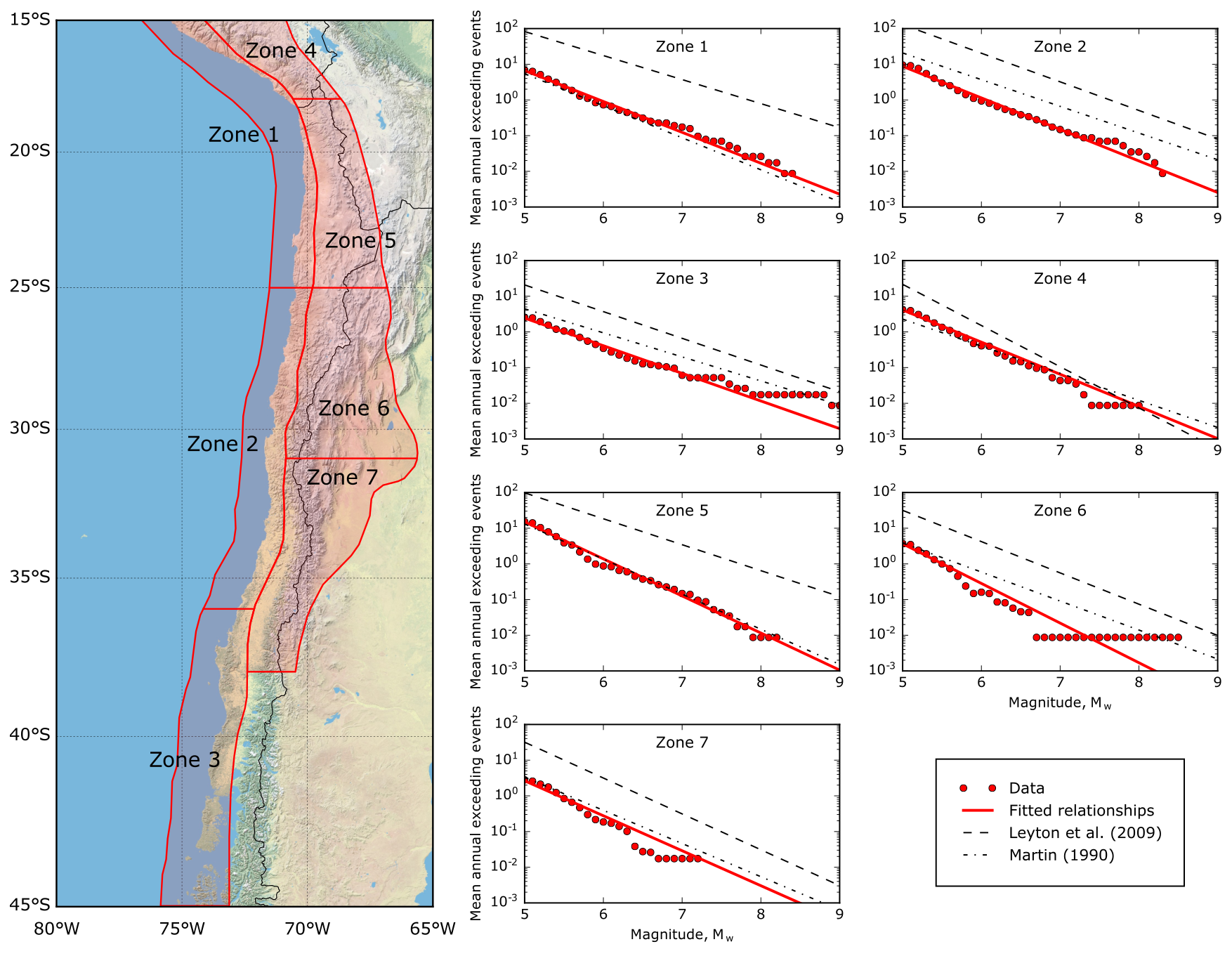 An updated recurrence model for Chilean subduction seismicity and statistical validation of its Poisson natureBulletin of the Seismological Society of America
An updated recurrence model for Chilean subduction seismicity and statistical validation of its Poisson natureBulletin of the Seismological Society of AmericaEarthquake recurrence models are the basis of seismic hazard analysis and seismic risk evaluation of physical infrastructure. They are based on statistical analysis of earthquake occurrence data available in a specific geographical region. This work proposes a new earthquake recurrence model for the interface and intraslab seismicity of the subduction margin along Chile. The model improves some of the shortcomings of previous available models in the region such as the lack of earthquake declustering or the use of magnitude scales inconsistent with modern ground-motion prediction equations. Significant differences in seismic rates are found with some previous models. Indeed, the resulting frequencies from the Gutenberg-Richter relations are not only similar to some of the previous works, but also one order of magnitude higher and lower than two of the previously reported models. Because one of the strongest assumptions in earthquake occurrence models is that they follow a homogeneous Poisson process, this hypothesis is statistically tested herein, finding that the declustered catalog only partially complies with this assumption, showing for instance that the interevent times follow approximately an exponential distribution.
- Modeling the impact of earthquake-induced debris on tsunami evacuation times of coastal citiesEarthquake Spectra
Tsunami alerts following severe earthquakes usually affect large geographical regions and require people to evacuate to higher safety zones. However, evacuation routes may be hindered by building debris and vehicles, thus leading to longer evacuation times and an increased risk of loss of life. Herein, we apply an agent-based model to study the evacuation situation of the coastal city of Iquique, north Chile, where most of the population is exposed to inundation from an incoming tsunami. The study evaluates different earthquake scenarios characterized by different ground motion intensities in terms of the evacuation process within a predefined inundation zone. Evacuating agents consider the microscale interactions with cars and other people using a collision avoidance algorithm. Results for the no ground shaking scenario are compared for validation with those of a real evacuation drill done in 2013 for the entire city. Finally, a parametric analysis is performed with ten different levels of ground motion intensity, showing that evacuation times for 95% of the population increase in 2.5 min on average when considering the effect of building debris.
- Seismic risk assessment of an emergency department of a Chilean hospital using a patient-oriented performance modelFavier, P., Poulos, A., Vásquez, J. A., Aguirre, P., and de la Llera, J. C.Earthquake Spectra
After an earthquake, hospital emergency departments need to provide continuous health care services to respond to the eventual sudden increase in injured people. The service performance of an emergency department is influenced by internal factors, such as physical damage and staff availability, and external factors, such as an increased patient arrival rate and disruptions in its supply chain. This research presents a quantification methodology for the performance of the emergency department. The novelty of the proposed approach lies in the explicit integration of the inelastic structural and nonstructural response of the building and damage with its loss of functionality, downtime, and emergency patient treatment rate. A discrete event simulation model is used to model the flow of patients within the different units of the emergency department. The seismic risk is expressed as return periods of exceeding different levels of patient waiting times. Results show that 1,000 and 30,000 accumulated waiting hours correspond to return periods of 100 and 1,000 years, respectively. It is concluded that this model may contribute to improving the risk management of critical emergency department infrastructure.
- Empirical site classification of seismological stations in Chile using horizontal-to-vertical spectral ratios determined from recordings of large subduction-zone earthquakesYang, S., Mavroeidis, G. P., de la Llera, J. C., Poulos, A., Aguirre, P., Rahpeyma, S., Sonnemann, T., and Halldorsson, B.Soil Dynamics and Earthquake Engineering
Despite the significant upgrade and expansion of the seismic monitoring network in Chile over the past several years, precise site characterization of a large number of seismological stations is still lacking, thus hindering a robust development of tools that could improve prediction of regional seismic hazard. To enhance our understanding of site effects in Chilean seismological data, this study classifies 136 stations using the horizontal-to-vertical spectral ratio (HVSR) method based on a database of 283 triaxial ground-motion records from 22 subduction interface earthquakes with moment magnitudes ranging from 6.8 to 8.8 that occurred between 1985 and 2015. This classification, which is based on the SESAME guidelines, divides recording stations into four types according to the shape of the station-average HVSR curve (single-peak, double-peak, broad/multiple-peak, and flat). Furthermore, the variability of the mean HVSRs with different source, path and site parameters is investigated. The derived HVSR results are also compared with those presented in previous HVSR studies for Chile. Finally, representative shear-wave velocity profiles along with parametric uncertainties are estimated for stations with a single-peak HVSR curve using a Bayesian statistical inversion framework.
2018
- Validation of an agent-based building evacuation model with a school drillPoulos, A., Tocornal, F., de la Llera, J. C., and Mitrani-Reiser, J.Transportation Research Part C: Emerging Technologies
An effective evacuation of buildings is critical to minimize casualties due to natural or anthropogenic hazards. Building evacuation models help in preparing for future events and shed light on possible shortcomings of current evacuation designs. However, such models are seldom compared or validated with real evacuations, which is a critical step in assessing their predictive capacities. This research focuses on the evacuation of a K-12 (kindergarten to 12th grade) school located within the tsunami inundation zone of Iquique, Chile. An agent-based evacuation model was developed to simulate the evacuation of approximately 1500 children and staff from the school during a global evacuation drill carried out for the entire city. The model simulates the motions of heterogeneous human agents, and the simulations were validated using video analysis of the real event. Resulting error estimations between predicted versus measured flow rates and evacuation times are 13.5% and 5.9%, respectively. The good agreement between the simulated and measured values can be attributed to the known distribution of students and staff at the start of the drill, and their known exposure to emergency preparedness protocols. However, the results presented herein show that this mathematical evacuation model can be used for logistical changes in the emergency planning.
2017
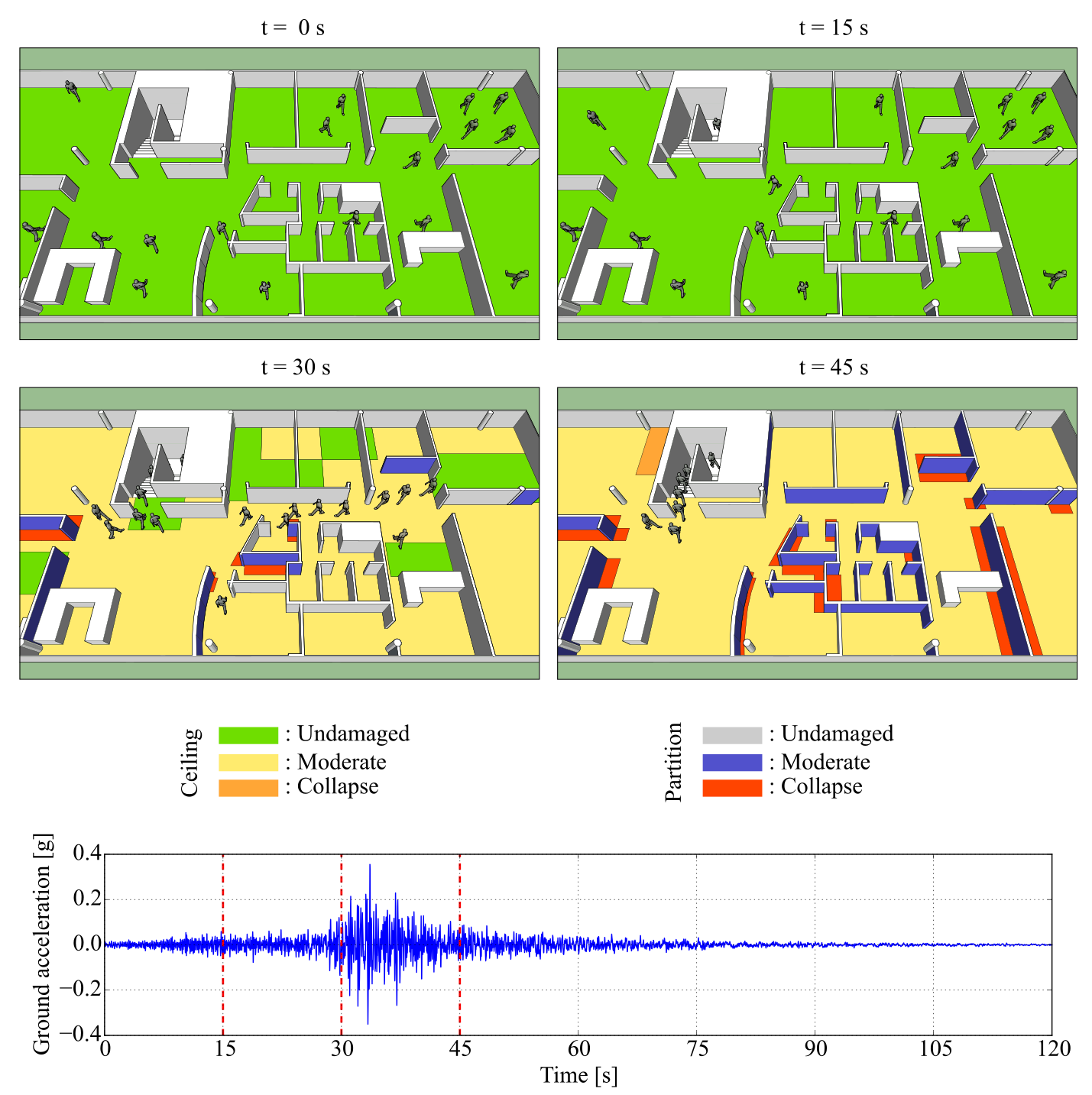 Earthquake risk assessment of buildings accounting for human evacuationPoulos, A., de la Llera, J. C., and Mitrani-Reiser, J.Earthquake Engineering & Structural Dynamics
Earthquake risk assessment of buildings accounting for human evacuationPoulos, A., de la Llera, J. C., and Mitrani-Reiser, J.Earthquake Engineering & Structural DynamicsA primary goal of earthquake engineering is to protect society from the possible negative consequences of future earthquakes. Conventionally, this goal has been achieved indirectly by reducing seismic damage of the built environment through better building codes, or more comprehensibly, by minimizing seismic risk. However, the effect that building damage has on occupants is not explicitly taken into account while designing infrastructure. Consequently, this paper introduces a conceptual framework and numerical algorithm to assess earthquake risk on building occupants during seismic events, considering the evacuation process of the structure. The framework combines probabilistic seismic hazard analysis, inelastic structural response analysis and damage assessment, and couples these results with the response of evacuating agents. The results are cast as probability distributions of variables that measure the overall performance of the system (e.g., evacuation times, number of injured people, and repair costs) for specific time windows. As a testbed, the framework was applied to the response of a reinforced concrete frame building that exemplifies the use of all steps of the methodology. The results suggest that this seismic risk evaluation framework of structural systems that combine the response of a physical model with human agents can be extended to a wide variety of other situations, including the assessment of mitigation actions in communities and people to improve their earthquake resilience.
Conference papers
- Poulos, A., and Miranda, E. (2024). Influence of faulting style on the directionality of earthquake response spectra. In 18th World Conference on Earthquake Engineering, Milan, Italy.
- Poulos, A., and Miranda, E. (2024). Accounting for ground motion directionality in regional seismic risk assessment. In 18th World Conference on Earthquake Engineering, Milan, Italy.
- Girmay, N., Poulos, A., Miranda, E., Bravo-Haro, M., Heresi, P., Dávalos, H., and Liapopoulou, M. (2024). Ground motion directionality effects in the 2023 Kahramanmaras, Türkiye earthquake sequence.. In 18th World Conference on Earthquake Engineering, Milan, Italy.
- Girmay, N., Miranda, E., and Poulos, A. (2024). Examination of directionality in the MW 6.4, Ferndale, California earthquake. In 18th World Conference on Earthquake Engineering, Milan, Italy.
- Silva-Lopez, R., Bhattacharjee, G., and Poulos, A. (2024). Probabilistically accounting for business interruption and bridge damage in road network performance. In 18th World Conference on Earthquake Engineering, Milan, Italy.
- Muñoz, J. P., de la Llera, J. C., Castro, S., Alberto, Y., Poulos, A., and Arróspide, F. (2024). Seismic risk sensitivity analysis of a large drinking water distribution network in central Chile. In 18th World Conference on Earthquake Engineering, Milan, Italy.
- Poulos, A., and Miranda, E. (2022). New orientation-independent measure of horizontal ground motion intensity that accounts for directionality in earthquake-resistant design. In 12th National Conference on Earthquake Engineering, Salt Lake City, UT.
- Muñoz, J. P., de la Llera, J. C., Poulos, A., Vásquez, J., and Rossetto, T. (2021). A calibrated simplified model for plane and regular R/C moment resisting frames. In 17th World Conference on Earthquake Engineering, Sendai, Japan.
- Castro, S., Arróspide, F., Poulos, A., Alberto, Y., and de la Llera, J. C. (2021). Construction and risk evaluation of a water distribution network under seismic hazard in central Chile. In 17th World Conference on Earthquake Engineering, Sendai, Japan.
- de la Llera, J. C., Monsalve, M., Ferrario, E., Allen, E., Chamorro, A., Castro, S., Alberto, Y., Arróspide, F., Poulos, A., Candia, G., and Aguirre, P. (2021). Earthquake response sensitivity of complex infrastructure networks. In 17th World Conference on Earthquake Engineering, Sendai, Japan.
- Monsalve, M., Ferrario, E., Alberto, Y., Arróspide, F., Castro, S., Poulos, A., and de la Llera, J. C. (2020). Evaluating network reduction strategies for consistent risk assessment of critical infrastructures. In Proceedings of the 30th European Safety and Reliability Conference, Venice, Italy.
- Ferrario, E., Monsalve, M., Poulos, A., de la Llera, J. C., and Sansavini, G. (2020). Estimating the impact of earthquake-induced power outages on different economic sectors in Chile. In Proceedings of the 30th European Safety and Reliability Conference, Venice, Italy.
- Ferrario, E., Poulos, A., de la Llera, J. C., Lorca, A., Oneto, A., and Magnere, C. (2019). Representation and modeling of the Chilean electric power network for seismic resilience analysis. In Proceedings of the 29th European Safety and Reliability Conference, Hannover, Germany.
- Castro, S., Poulos, A., Urrutia, A., Herrera, J. C., Cienfuegos, R., and de la Llera, J. C. (2018). Impact of earthquake magnitude on the estimation of tsunami evacuation casualties. In 11th National Conference on Earthquake Engineering, Los Angeles, CA.
- Poulos, A., Monsalve, M., Zamora, N., and de la Llera, J. C. (2018). Statistical assumptions of mainshock sequences and their validity under different magnitude ranges. In 16th European Conference on Earthquake Engineering, Thessaloniki, Greece.
- Espinoza, S., Poulos, A., Rudnick, H., de la Llera, J. C., Panteli, M., Mancarella, P., Sacaan, R., Navarro, A., and Moreno, R. (2017). Seismic resilience assessment and adaptation of the Northern Chilean power system. In 2017 IEEE Power & Energy Society General Meeting, Chicago, IL.
- Poulos, A., Espinoza, S., de la Llera, J. C., and Rudnick, H. (2017). Seismic risk assessment of spatially distributed electric power systems. In 16th World Conference on Earthquake Engineering, Santiago, Chile.
- Poulos, A., Castro, S., de la Llera, J. C., and Mitrani-Reiser, J. (2017). Seismic risk assessment of human evacuation in buildings. In 16th World Conference on Earthquake Engineering, Santiago, Chile.
- Favier, P., Rivera, F., Poulos, A., Vásquez, J., de la Llera, J. C., and Mitrani-Reiser, J. (2017). Impact on Chilean hospitals following the 2015 Illapel earthquake. In 16th World Conference on Earthquake Engineering, Santiago, Chile.
- Rivera, F., Jünemann, R., Candia, G., Favier, P., Fernández, C., Chacón, M., Hube, M., Chamorro, A., Aguirre, P., de la Llera, J. C., and Poulos, A. (2017). Reconnaissance observations by CIGIDEN after the 2015 Illapel, Chile earthquake and tsunami. In 16th World Conference on Earthquake Engineering, Santiago, Chile.
- Poulos, A., Favier, P., J., Vásquez, and de la Llera, J. C. (2015). Scenario-based seismic performance assessment of a Chilean hospital. In Proceedings of the 10th Pacific Conference on Earthquake Engineering, Sydney, Australia.
- de la Llera, J. C., Mitrani-Reiser, J., Rivera, F., Fortuño, C., Jünemann, R., Poulos, A., and J., Vásquez (2015). The 2010 Chile Earthquake: a five-year reflection. In Proceedings of the 10th Pacific Conference on Earthquake Engineering, Sydney, Australia.
- de la Llera, J. C., Vásquez, J., Poulos, A., and Favier, P. (2015). Trends in research and design of structures with seismic protection systems. In XI Congreso Chileno de Sismología e Ingeniería Sísmica, Santiago, Chile.










